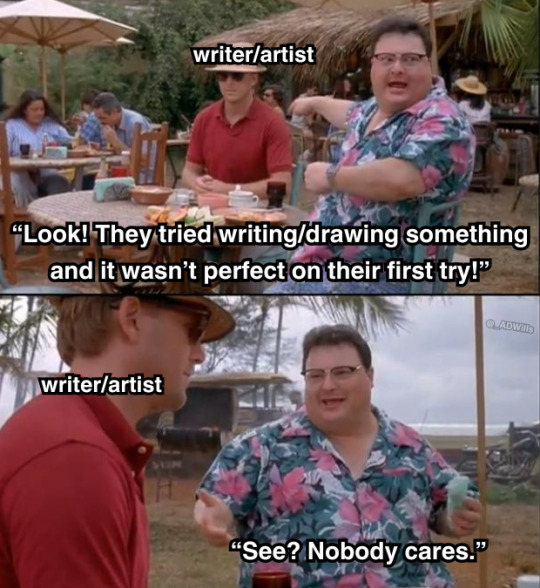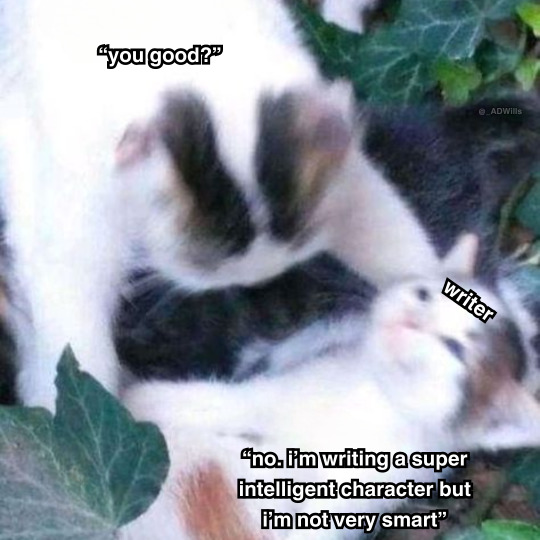Safe space for black non men. Still trying to figure out what I want to do with my blog, but I'mma figure it out. 💖🌱
Don't wanna be here? Send us removal request.
Text
sometimes you need dialogue tags and don't want to use the same four


175K notes
·
View notes
Text
Where are the local black farmers? Eggs is too damn expensive! We need y'all fr. 😩
0 notes
Text
This part. Male centered women are honestly sad and in need of healing. Many are a lost cause, but I still feel bad for them. They are really willing to sacrifice themselves, other women, their female friends, their peace of mind, their rights, and their dignity on the dream that a man will look their way and throw them a bone. Like I cannot rock with women like that at all.
Literally can’t be friends with someone who centers men ever again

2K notes
·
View notes
Text
This is a really good point. I've come to realize that when something is so normal and integrated into everyday life, it's easy to forget the magic of it. It's easy to overlook how much this has added to our lives because most of us don't remember a time without the ability to record audio. So we don't give a second thought, and we take it for granted. It's really interesting to think about. I love topics like this.
sometimes I think too hard about like. how the ability to record audio fundamentally changed how humans interact with music. can you imagine if the only time you ever heard music in your whole life was when you or another human being in your actual physical presence decided to create it. and 99.99% of the time that person was not a professional but just like your wife or your dad or your co-worker or church choir singing or playing whatever they happened to know. i honestly don't think we can fathom it
49K notes
·
View notes
Text
Saw a tiktok of a guy saying he doesn’t feel comfortable talking to minors because he’s 19. And it’s just. I’m so fucking tired of this.
And like to be clear, I’m speaking as a victim of pedophilia when I say: We need to get over this collective fear of endangering children. Because holy shit, this stuff is getting out of hand.
The average person is not a threat to a child.
And also!!! It is actually really really good for kids to have friendships with adults that aren’t their family.
Having friendships with adults when you’re younger prepares you for adult life in a better way then only interacting with adults that are family members or teacher as well.
And also if there’s any sort of weird behavior happening with adults or teachers, it’s very helpful to have unrelated adults, you can go to, and also have a model for what normal adults are supposed to look like.
And also! You’re just making it way easier for pedophiles to prey on children when you completely avoid interacting with them as an adult. Because kids are naturally inquisitive and curious. They are going to want to interact with adults and they are going to want to ask questions. And if the only adult adults that are willing to interact and speak with them or adults who have ulterior motivations. Guess what’s gonna happen.
Also on a more general note. Having a model for what a normal healthy adult is supposed to look like makes it way easier for kids to be able to recognize and identify when adults in their personal life are being weird.
42K notes
·
View notes
Text
reblog if you believe fanfics are as valid as books that were published and sold by authors who write as their main careers. I'm trying to prove a point
40K notes
·
View notes
Text
Master Dialogue Writing Techniques for Engaging Fiction (For Writers)
(Beware, long post!)
As fiction writers, we all know that effective dialogue is essential for bringing our stories and characters to life. After all, the way our protagonists, antagonists, and supporting players speak to one another is one of the primary ways readers get to know them on a deep, intimate level. Dialogue reveals personality, uncovers motivation, and propels the narrative forward in a way that felt narration simply can't match.
But nailing natural, compelling dialogue is easier said than done. It's a craft that takes serious skill to master, requiring writers to have a keen ear for authentic speech patterns, a nimble handle on subtext and implication, and the ability to strike that delicate balance between being true to real-world conversation while also keeping things snappy, dynamic, and laser-focused on the story at hand.
If you're someone who struggles with crafting dialogue that truly sings, never fear. In this in-depth guide, I'm going to dive deep into the techniques and best practices that will help you elevate your dialogue writing to new heights. By the end, you'll have a toolbox full of strategies to ensure that every exchange between your characters is as gripping, revealing, and unforgettable as possible.
The Fundamentals of Effective Dialogue
Before we get into the more advanced nuances of dialogue writing, let's start by covering some of the foundational principles that all great fictional conversations are built upon:
Reveal Character One of the primary functions of dialogue is to give readers a window into who your characters are as people. The way they speak — their word choices, their tone, their body language, their turns of phrase — should provide vivid insight into their personalities, backgrounds, values, quirks, and emotional states.
Think about how much you can glean about someone just from how they communicate in real life. Do they use a lot of slang and shorthand? Are they verbose and flowery with their language? Do they struggle to make eye contact or fail to respond directly to questions? All of these subtle linguistic cues are powerful tools for crafting multi-dimensional characters.
Drive the Plot Forward While revelations about character are crucial, you also want to ensure that your dialogue is constantly pushing the story itself forward. Each exchange should feel purposeful, moving the narrative along by introducing new information, triggering plot points, creating conflict, or prompting characters to make pivotal decisions.
Dialogue that feels aimless or extraneous will ultimately bore readers and detract from the forward momentum of your story. Every line should have a clear intent or function, whether it's uncovering a hidden truth, setting up a future complication, or escalating the tension in a high-stakes moment.
Establish Distinct Voices In a story featuring multiple characters, it's crucial that each person has a clearly defined and differentiated way of speaking. Readers should be able to tell who's talking just from the rhythm, diction, and personality of the dialogue, without any additional context clues.
This doesn't mean every character has to have an over-the-top, hyper-stylized way of communicating. In fact, the most effective character voices often feel grounded and natural. But there should still be distinct markers — whether it's word choice, sentence structure, tone, or speech patterns — that make each person's voice instantly recognizable.
Convey Subtext While the literal words being spoken are important, great dialogue also traffics heavily in subtext — the unspoken emotional undercurrents, power dynamics, and hidden agendas that simmer beneath the surface of a conversation.
The most compelling exchanges happen when characters are communicating on multiple levels simultaneously. Perhaps they're saying one thing out loud while their body language and tone convey a completely different sentiment. Or maybe they're engaged in a subtle war of wits, trading verbal jabs that reveal deeper wells of resentment, attraction, or vulnerability.
Mastering the art of subtext is key to creating dialogue that feels layered, lifelike, and imbued with dramatic tension.
Strategies for Writing Snappy, Realistic Dialogue
Now that we've covered the foundational principles, let's dive into some specific techniques and best practices that will take your dialogue writing to the next level:
Omit Unnecessary Details One of the biggest mistakes many writers make with dialogue is bogging it down with too much extraneous information. In real life, people rarely speak in perfectly composed, grammatically correct full sentences. We stumble over our words, interrupt each other, trail off mid-thought, and pack our speech with filler words like "um," "uh," and "you know."
While you don't want to go overboard with mimicking that messiness, you should aim to strip your dialogue of any overly formal or expository language. Stick to the essentials — the core thoughts, feelings, and information being exchanged — and let the subtext and character voices do the heavy lifting. Your readers will fill in the gaps and appreciate the authenticity.
Master the Art of Subtext As mentioned earlier, crafting dialogue that's rich in subtext is one of the keys to making it feel gripping and lifelike. Think about how much is often left unsaid in real-world conversations, with people dancing around sensitive topics, conveying hidden agendas, or engaging in subtle power struggles.
To layer that sense of unspoken tension into your own dialogue, consider techniques like:
• Having characters contradict themselves or say one thing while their body language says another
• Utilizing loaded pauses, interruptions, and moments of uncomfortable silence
• Injecting subtle sarcasm, skepticism, or implication into a character's word choices
• Allowing characters to talk past each other, missing the unspoken point of what the other person is really saying
The more you can imbue your dialogue with that layered, emotionally-charged subtext, the more it will resonate with readers on a deeper level.
Establish Distinct Voices As mentioned earlier, ensuring that each of your characters has a clearly defined and differentiated speaking voice is crucial for great dialogue. But how exactly do you go about accomplishing that?
One effective strategy is to give each person a unique set of verbal tics, idioms, or speech patterns. Maybe one character is prone to long-winded, flowery metaphors, while another speaks in clipped, efficiency-minded sentences. Perhaps your protagonist has a habit of ending statements with questioning upticks, while the sarcastic best friend always punctuates their barbs with an eye roll.
You can also play with differences in diction, syntax, and even accent/dialect to further distinguish how your characters communicate. The key is to really get to know the unique personality, background, and psychology of each person — then let those elements shine through in how they express themselves.
Lean Into Conflict and Confrontation When it comes to crafting gripping dialogue, conflict is your friend. The most compelling exchanges often arise from characters butting heads, engaging in verbal sparring matches, or working through deep-seated tensions and disagreements.
Conflict allows you to showcase the high stakes, unresolved needs, and deeper emotional currents that are driving your characters. It forces them to make bold choices, reveals aspects of their personalities that might not otherwise surface, and generates the kind of dramatic tension that will really hook your readers.
Of course, you'll want to avoid making every single dialogue scene a full-blown argument. But learning to sprinkle in well-placed moments of friction, confrontation, and clashing agendas is a surefire way to elevate the energy and impact of your character interactions.
Read Your Dialogue Out Loud One of the most valuable tricks for ensuring your dialogue sounds natural and lifelike is to read it aloud as you're writing. Hearing the words out loud will quickly expose any clunky phrasing, overly formal grammar, or inauthentic rhythms that would otherwise go unnoticed on the page.
Pay close attention to how the dialogue rolls off your tongue. Does it have a smooth, conversational flow? Or does it feel stilted and unnatural? Are your characters' unique voices shining through clearly? Are there any spots where the back-and-forth starts to drag or feel repetitive?
Actively listening to your dialogue — and making adjustments based on how it sounds in the real world — is an essential part of the writing process. It's one of the best ways to refine and polish those character interactions until they feel truly alive.
Hopefully, this can help you all!
The key is to always keep your focus on authenticity. Ask yourself: how would real people actually speak?
Hey fellow writers! I'm super excited to share that I've just launched a Tumblr community. I'm inviting all of you to join my community. All you have to do is fill out this Google form, and I'll personally send you an invitation to join the Write Right Society on Tumblr! Can't wait to see your posts!

884 notes
·
View notes
Text
😂😂😂

28K notes
·
View notes
Text
Thank you for giving me permission, and usually I would, but I'm very hyper fixated on one story rn, and Everytime I try to do something else my brain finds a way to link it back to that one story. 😭

It never ends
11K notes
·
View notes
Text
She's such an icon.



Ayo Edebiri for Vanity Fair, styled by Stella Greenspan
2K notes
·
View notes
Text
This is such a sweet message and resonates so hard rn, because I feel so burnt out. Masking, and dealing with the chaos in the world takes so much out of me. Just gathering the will to do basic things like get out of bed, or shower, or brush my teeth is tiring, and I'm already putting so much energy into bettering my mental health. But I wanna write, I wanna create art, but sometimes I'm too exhausted too. Most times I'm already struggling with being neuro divergent in a dystopian world masquerading as an advanced civilization, so I just don't have the time, energy, and motivation to write and create art like I want. And that breaks my heart honestly because writing and creating art is one of my life passions.
Here's to the people who can't get the words on the page. The people who are too tired after all life throws at them to write. The people who are blocked. The people who are burnt out. The people who can't write because of physical or mental illnesses. The people who don't know why they can't write. And the people struggling with all those other things that get in the way of writing and make it seem or be impossible.
You're still a writer, you're still an artist. And you matter. This world is better since you're in it. Thank you for wanting to write, even if you can't right now. I hope you and your words find each other soon.
#writeblr#writeblr community#writers on tumblr#writing encouragement#neurodiversity#neurodivergent#mental health#tw depressing thoughts#chronic depression#spiritual awakening#anti capitalism#fuck capitalism#writing positivity#relatable#writers block
16K notes
·
View notes
Text
Someone in an autism facebook group I'm in just asked "How am I supposed to earn enough to make a living without burning out?"
Someone replied: "You're not. Even neurotypicals can't right now in the system designed for them. We're the canaries in the coalmine. When we start failing, they know something is wrong."
87K notes
·
View notes
Text
Palestinians in Israeli prisons, and that includes men, women, and children, are subjected to torture, sexual violence, threats of rape and killing their loved ones, and they get KILLED. The "only democracy in the Middle East" is nothing but a colonial and imperial power that torments and kills the innocent. Keep talking about Palestine!
7 March 2024

10K notes
·
View notes
Text
Reminder that you're actually interesting. Your hobbies are interesting, your interests are interesting, you are important and loveable and people appreciate you. You're just a loveable, interesting person.
32K notes
·
View notes


